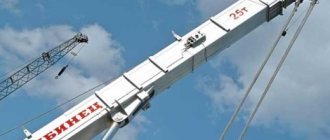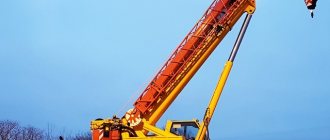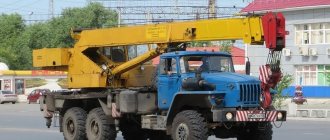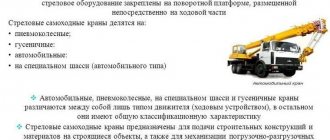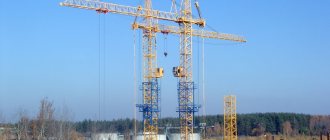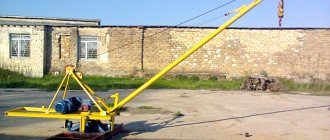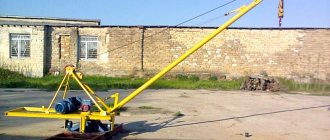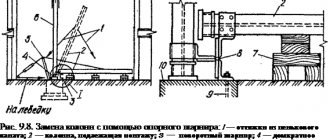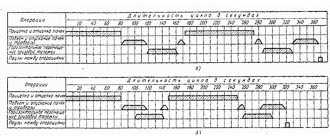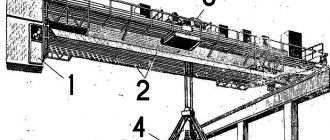Manufacturers
Automotive cranes are manufactured by various companies in different countries.
| Manufacturer | Class | Load capacity min./max., t | A country |
| Ivanovets | Mid-ton truck on a free chassis | from 16 to 80, as well as | Russia |
| Chelyabinsk | from to 50 | ||
| Galician | from to 100 | ||
| KATO | Heavy duty on its own chassis | from 60 to 150 | Japan |
| Komatsu | from 30/ to 00 | ||
| Zoomlion | limit 2000 | China | |
| XCMG | limit 1600 | ||
| Liebherr | All | from 5 to 1200 | Germany, Austria, Switzerland |
| Terex | from 30 to 1200 | USA | |
| Gazpromkran | Mid-ton truck on a free chassis | from 5 to 30 | Russia |
| Grove | Heavy duty on its own chassis | limit 450 | Germany |
| Krupp | limit 200 | ||
| TAKRAF | Railway, truck crane | limit 200 | |
| Tadano | Light and medium free-launching | limit 50 | Japan |
| Lokomo | Medium and heavy on their own chassis | from 20 to 100 | Finland |
Types of truck crane work
Truck cranes are used to perform a variety of types of work. A truck crane is capable of performing a variety of types of work related to lifting and reloading lump, packaged or bulk materials.
They are actively used by utility and repair services, used in construction, reconstruction of buildings and facilities, during rescue operations, etc. The main types of truck crane work are as follows:
- laying pipelines and other utility networks;
- loading into open bodies or wagons;
- unloading from open bodies or wagons;
- Men at work;
- installation of block structures;
- lifting construction materials and equipment;
- moving heavy machinery, cars, metal structures.
These are not all types of work for which truck cranes are used. The versatility and multifunctionality of this special equipment make it in demand in various fields.
Types of truck crane booms
Most modern models of truck cranes are equipped with telescopic booms. The boom mechanism consists of several retractable sections. This retractable design can support significant weight and is also highly flexible. If we consider domestic models of truck cranes, then their maximum number of retractable sections is 5.
If a larger structure is required, it is more rational and convenient to use a mobile crane with a tower boom. It differs from the telescopic design by its higher lifting height. Tower cranes are used in the construction of high structures.
Types of truck cranes by type of working mechanism
It is possible to distinguish types of truck cranes based on one more characteristic - the type of working equipment. Today, machines with removable equipment are most widespread: by changing the working unit, you can perform a wider range of tasks using the same truck crane. Truck cranes are equipped with:
- hook;
- grab.
Type of truck crane with a grab grip for bulk materials. The hook suspension is convenient when working with large cargo or packaged items. For example, these types of truck cranes can unload wagons or trailers with pallets packed with building materials, etc. If it is necessary to reload bulk or lump materials, then other types of truck cranes are used - equipped with a grab grip.
Functional Features
Truck cranes are widely used in various fields. Depending on the design features, you can perform tasks such as:
- Working with heavy and bulky loads;
- In urban conditions;
- In hard-to-reach places;
- In places with difficult terrain.
There are several modifications by which the arrows are divided, depending on the operating conditions. To solve the assigned tasks, a truck crane is selected according to its technical characteristics. The load capacity indicator depends on the operational features.
Options
Parameters are the basic quantities that characterize the crane. The main parameters of jib cranes are:
Tilt and rotate
For jib slewing cranes, it must be possible to lift the largest working load on the design slope in all positions of the rotary part.
The calculated angle of inclination is an angle whose value is:
When working on outriggers for jib cranes, the tilt angle can be 1° 30″. The design angle of inclination with tower-boom equipment is determined by the design organization and is indicated in the crane's passport (in the USSR it was introduced by the information and directive letter of the USSR State Mining and Technical Supervision of August 26, 1971).
The largest manufacturers of cranes
To date, the crane market can offer customers both domestic and foreign models. The production of special equipment of this type is carried out by a number of Russian companies, CJSC Inman, VELMASH-S, the previously mentioned companies HIAB and Palfinger, the Italian supplier Amco Veba, the Japanese company UNIC and many others. etc.
Compact cranes with low dead weight are produced by BAKM CJSC, whose production base is located in Balashikha (Moscow region). A manufacturer from Bashkortostan, Inman CJSC, supplies the market with a wide variety of models of loader cranes with Z-shaped boom equipment. When assembling the CMU, imported components are widely used (from Swedish, Italian, Finnish suppliers). Increased rigidity of the arrows is ensured by the use of a durable hexagonal profile in their manufacture.
The Swedish company HIAB, one of the world leaders in the production of loader cranes, offers customers a huge range of cranes with a load moment from 1 to 80 tm and a maximum boom radius from 2 to 27 m. All installations have a wide range of operating temperatures (from - 40 ° C to +50°C).
The well-known Italian company Amco Veba produces 3 series of cranes: “Standard” (universal models), “C” (installations with a reverse boom) and “E” (machines of a simplified design)
The manufacturer pays great attention to the safety of its products, which is reflected in the slogan
CMUs manufactured under the UNIC brand are supplied to more than one hundred countries around the world. This equipment is distinguished by traditionally high manufacturing precision for Japanese products, while maintaining productivity and load capacity at the level of the best European models of crane units.
General characteristics of jib self-propelled cranes and their classification
Hide advertisements in article
Hide advertisements in article
Self-propelled jib cranes are widely used in the construction industry due to their maneuverability and the ability to work without installing a special crane runway. They are used mainly for installation and loading and unloading operations.
Each jib crane consists of the following assembly units: a chassis with a running device, a fixed frame, a rotating platform connected to the base chassis through a slewing bearing, a drive unit, actuators and working equipment.
The main mechanisms of a self-propelled crane are: a mechanism for lifting loads, changing the reach of the hook, mechanisms for rotating the platform and moving the crane. Heavy-duty cranes have two lifting mechanisms - one for large and one for small loads.
Each crane has a cabin for the crane operator with a control panel located in it. Some cranes have two cabins, one of which is used to control the movement of the crane, and the second to control lifting operations. The cranes are equipped with a set of control safety equipment.
The working equipment of self-propelled jib cranes is made in the form of a rope-suspended straight boom, a rope-suspended boom with a jib, a rope-suspended telescopic (see Fig. 65), a rigidly suspended telescopic (Fig. 101.6), as well as in the form of a tower boom equipment (Fig. 101, a).
Jib cranes equipped with booms with a controlled jib ensure that loads can be lifted to great heights with a significant hook reach. However, the inclined position of the boom narrows the possibilities of using the space under the boom by size L (see Fig. 101, a). When using tower-boom equipment, the service area in plan increases by 2 times.
Rice. 101. Diagram of jib equipment for jib self-propelled cranes
a - straight boom and tower-boom equipment; b - rigidly suspended telescopic boom
The main parameters of jib self-propelled cranes for general purposes are standardized by GOST 9692 - 71. This GOST provides the following standard range of lifting capacities of jib cranes: 6.3; YU; 16; 25; 40; 63; 100; 160 and 250 tons. The indicated lifting capacity of jib cranes is the maximum permissible with a minimum boom radius, which is established by the same GOST.
Technical requirements for the quality of jib cranes are established by GOST 11556 - 71, and the terminology related to them is GOST 15135 - 69.
According to the design of the running gear, self-propelled jib cranes are divided into automobile cranes, mounted on a standard automobile chassis; tractor, the base of which is a standard tractor; pneumatic; pneumatic tires of automobile type; tracked and railway.
In each of these groups, cranes are classified by lifting capacity, type of power equipment (diesel or carburetor engine), type of drive from the power plant to the actuators (mechanical, electrical, hydraulic), type of working equipment, type of boom (straight, telescopic, jib boom , tower with arrow).
To designate models of jib cranes, an indexing system has been adopted, consisting of the letters KS, indicating that the machine belongs to jib cranes; four numbers and two letters.
The first serial digit after the letters KS indicates the load-carrying capacity group, which corresponds to a certain load-carrying capacity value.
Load capacity group…….
| 1 | 2 | 3 | 4 | 5 | 6 | 7 | 8 |
| 4 | 6,3 | 10 | 16 | 25 | 40 | 63 | 100 |
The second serial digit indicates the type of running equipment, with the caterpillar drive being designated by the number 1, the wide track track - 2, the pneumatic wheel - 3, the automobile-type chassis - 4, the automobile - 5, the tractor - 6, the trailed - 7.
The third ordinal number indicates the type of boom equipment: number 6 means rope-suspended, 7 means rigidly suspended, 8 means telescopic sliding. The fourth serial digit indicates the next model number.
The letter following the numbers indicates the modernization number, and the last one - C, T (or TV) corresponds to the type of execution - northern, tropical and tropical wet.
For example, the brand of machine KS-5463BS means: a crane with a lifting capacity of 25 tons, on an automobile-type chassis, with rope-suspension boom equipment, the third model, the second modernization, in the northern version.
Other articles from the section “Jib cranes”:
> ·
General characteristics of self-propelled jib cranes and their classification
·
Automotive cranes
·
Pneumatic wheel cranes
·
Stability of self-propelled jib cranes
Navigation: Home | Other books | Reviews:
Is it easy for a crane operator these days?
Let's repeat: a modern crane is an incredibly high-tech machine, and the crane operator's cabin looks no worse than the pilot's cockpit. An instrument panel, an LCD display, a remote control with many buttons, joysticks for controlling the cargo and boom winches - here, as in the newest airliners, the fly-by-wire principle, or control by wire, reigns. In other words, everything that comes from the crane operator’s cabin is digital commands sent via data buses to the electronic units of electromechanical actuators. Any work begins with the selection of preset parameters presented on the display using a graphical interface. The weight and type of ballast, the design of the boom, the type of suspension are selected, restrictions are introduced on the angle of rotation of the boom and the movement of the load. During the work, the “human factor” is under computer control. In particular, the “load moment limiter” program guarantees that under normal conditions any, including not entirely correct, actions of the crane operator cannot lead to the machine tipping over. Unless something unpredictable and beyond human control happens - for example, ground subsidence.
The article “Nodding Mastodons” was published in the magazine “Popular Mechanics” (No. 10, October 2010).
Design
The construction jib crane design includes:
- running gear;
- a fixed frame connected to the running mechanism;
- a rotating platform carrying lifting equipment, crane mechanisms, and an operator’s cabin;
- a turning mechanism, which is an intermediate unit between the fixed frame and the rotating part of the machine.
Boom equipment is used in 2 types. Arrows are used:
- lattice;
- telescopic.
Type 1 lifting elements can be:
- straight;
- non-rectilinear - suspended at the inflection point on a pulley;
- stackable - including interconnected insert sections;
- articulated, having a jib fixed at the top with hinges.
The boom structure of a telescopic type truck crane is a box-shaped structure consisting of sections placed inside each other and pulled out during operation. Telescopic booms represent the main equipment of hydraulically driven units. They are supported by hydraulic cylinders, and they also change the angle of the boom.
Technical characteristics of jib self-propelled cranes include:
- dimensions;
- track, base;
- performance;
- lifting capacity - the largest weight of cargo lifted by the machine;
- length, angle of rotation, tilt of the boom, its reach, which can be constant or variable;
- the height to which the hook rises;
- the speed at which the machine moves, the load is raised and lowered, the platform rotates, and the hook is extended;
- rotation speed;
- load characteristic, displaying the dependence of the unit’s load capacity on the hook reach;
- loading and tipping moments;
- total weight;
- power, type and number of drives.
Main modifications
The first models of truck cranes were equipped with lattice solid booms on a cable suspension. When installing them, the hook and suspension are reinforced with strong cables. Thanks to the lattice design, they are distinguished by their low weight.
At the same time, telescopic booms formed by several retractable segments are most in demand today. The retractable design is highly flexible and can withstand significant loads. The maximum number of sections that domestic industry can produce today reaches five.
In many cases, it is more convenient to use cranes with tower booms, since they are distinguished by a significant lifting height. This type of equipment is used mainly in the construction of high-volume structures.
Basic technical data of jib cranes
By the nature of work on railway transport, rail-mounted cranes are the most common, although crawler-mounted and pneumatic cranes are also used. Cranes consist of two main parts: a running platform and a lifting and slewing frame with a boom and load-handling devices. The rotating frame also houses the power unit, the main operating mechanisms of the crane, a boom with load-handling devices and controls.
Each self-propelled full-rotating jib crane has at least four mechanisms: lifting the load, changing the boom reach, rotating the top of the crane, and a mechanism for moving the crane self-propelled. All ethn mechanisms can be driven from individual drives or in combination from one power drive.
In Fig. 1, 2 show full-rotating jib cranes, rail-mounted cranes with a lifting capacity of 15, 16 tons.
The technical characteristics of the crane are the lifting capacity, the power of the power drive and the total power of the installed engines, the speed of lifting the load and moving the crane self-propelled, the time of complete change of the boom radius, the rotational speed of the rotating frame of the crane, the maximum lifting height of the load-handling device, the radius described by the rotating part of the crane, overall dimensions , weight of the crane and permissible speed of transportation of the crane as part of the train.
The power of thermal engines (steam, internal combustion engines) is expressed in horsepower (hp), and electric in kilowatts (kW).
The speed of lifting cargo and self-propelled movement is expressed in meters per 1 minute (m/min), and the speed of transporting a crane as part of a train is expressed in kilometers per 1 hour (km/h).
The time it takes to raise or lower the crane boom from one extreme position to the other is expressed in minutes (min).
The speed of rotation of the crane's upper frame is characterized by the rotation speed.
The boom reach is the horizontal distance between the axis of rotation of the crane and the vertical line passing through the load suspension point.
The size of the area served by the crane depends on the reach of the boom: the greater the reach, the larger this area; but as the reach increases, the possibility of the crane overturning increases, as its stability decreases; therefore, as the reach increases, the weight of the load being lifted must be reduced. For increased stability and the ability to lift heavier loads
Rice. 1. Diesel-electric crane KDE-161 with a lifting capacity of 16 tons:
1 — crane portal; 2-crane body; 3 - cargo boom; 4 — rotating part of the crane; 5 — rotating support; 6 — diesel generator set; 7 — muffler; 8 — boom lifting mechanism; 9 — cable holder; 10 — control station; 11 — running trolley; 13 — lower running frame; 13 — cargo winch; 14 — outrigger; 15 — movement mechanism; 16 — fuel tank; 17 — rotation mechanism; 18 — driver’s seat; 19 — control panel
/ — cargo drum shaft; 2 - main shaft; 3 — vertical drive shaft of wheelsets; 4- horizontal shaft of the boom lifting mechanism; 5 — horizontal rotation shaft; 6 — vertical shaft of the boom lifting mechanism; 7 - main valve; 8 - steam regulator; 9 — boom drum axis; 10 — boom lift drum; //- vnlka; 12 — traverse; 13 — cargo drums; 14 - load capacity indicator; 15-upper support ring; 16 — support rollers; 17- lower support ring; 18-nut of the central kingpin; 19 — central kingpin; 20 — vertical rotation shaft; 21 — horizontal wheel pair drive shaft; 22 — cam clutch; 23 — manual drive of the trolley brake; 24 — rotation clutches; 25 — rotation brake; 26 — load clutches; 27 — load brakes; 28 — wheel pair drive clutches; 29 — wheel drive brake; 30 — trolley air brake drive; 31 — outrigger; I - worm; And — gear of the boom lifting mechanism; III - crown of rotation; IV - cylindrical gear of the vertical rotation shaft; V - cylindrical gear of the horizontal wheel pair drive shaft; VI - lower bevel gear of the vertical wheel pair drive shaft; VII - bevel gear of the horizontal wheel pair drive shaft; VIII - split spur gear; IX — cylindrical gear of the cargo drum shaft; X - spur gear of the main shaft; XI - intermediate gear; XII - left cylindrical gear of the horizontal shaft of the boom lifting mechanism; XIII - bevel gear of the horizontal shaft of the boom lifting mechanism; XIV - bevel gear of the horizontal rotation shaft; XV - bevel gear of the horizontal rotation shaft; XVII — right cylindrical gear of the horizontal shaft of the boom lifting mechanism; XVIII—
Jib crane drive
The main working element is the drive, which is responsible for moving goods. The most common type of jib crane is the one with a mechanical drive. All components in it are driven by an internal combustion engine running on diesel fuel or gasoline.
Electric cranes are widely used on urban construction sites where they are connected to electrical lines. For autonomous operation they require the installation of a diesel generator. In this regard, special equipment with a hydraulic drive has become popular outside the city limits, where each mechanism of the machine is equipped with its own hydraulic motor.
In this case, cranes are divided into single-engine, where all working units are driven by power plants operating on one shaft, and multi-engine, where each mechanism receives movement from its own separate engine.
This is interesting: How to make a construction crane with your own hands
Railway crane
A railway crane on rails is a fully rotating, self-propelled mechanism on railway rails. The devices are used for loading work in warehouses of reinforced concrete panels, unloading blocks at a construction site, and installation during the construction of industrial buildings.
In order to be able to service warehouses for bulk materials, railway devices are often supplemented with a grab.
The railway unit consists of:
- rotating platform;
- high-tech boom;
- durable frame;
- reliable power unit;
- mechanism systems;
- driver's cabin;
- rotary support system;
- worker node.
Modern rail-mounted cranes with a lifting capacity of less than 15 tons are used without outriggers. Units that lift loads exceeding 15 tons operate on supports. The units can perform the following functions:
- lifting load;
- rotation of the unit;
- movement of the device with a load;
- change in boom radius.
Rail-mounted jib cranes can move independently or be attached to railway trains.
Laying crane UK-25 9-18
The UK-25/9-18 laying crane is used for assembling and dismantling railways with rails weighing up to 18 tons, length up to 25 m when laying or repairing railway tracks.
The tracklayer UK-25/9-18 has the following technical characteristics:
- Traction force - 100 kN.
- Diesel power is 121 kW.
- Track width - 1435, 1520 mm.
- The lifting capacity of the unit is 18 tons, the platform is 40 tons.
- The length of the railway link is 25 m.
- Speed - 80 km/h (during transportation), 20 km/h (self-propelled).
- Dimensions: 43330x6820 mm.
- Weight - 102 tons.
Laying crane UK-25 25
The UK-25/25 track-laying crane has a high lifting capacity and is equipped with a telescopic rotary truss. The unit has the ability to telescopically rotate the boom. The mechanism is used for the installation of railway tracks. It can lay links 25 m long and weighing 25 tons. The unit is self-propelled. When performing work, it is the main machine of track-laying complexes.
What is a construction tower crane
Tower construction cranes are a structure that looks like a tower on a supporting metal support. In addition to lifting to the required height, such a technique is capable of moving various loads along the reach of the boom, as well as rotating it around the central drain. As a result, cargo can be delivered to any point of the construction site, which significantly speeds up and simplifies the work.
Tower cranes allow you to lift building elements to great heights
Tower crane structure
Most modern cranes consist of 5 main parts:
- A tower made in the form of a top- or bottom-rotating structure made of pipes. Most models can be easily increased in height and can also be dismantled directly on the construction site.
- The supporting part, which is the load-bearing element. It bears the entire weight of the structure, vertical as well as overturning loads. In this regard, the most serious requirements are placed on this part.
- The working boom is an element that is located perpendicular to the supporting part. The construction of a tower crane boom can be of a beam or articulated type. It also contains a cargo trolley made of pipes or profiles. In total, the arrow can be one of several types: hammer-shaped or suspended.
- Running device. It is a mechanism that ensures turns, as well as the movement of cargo along the boom. Usually represented by a rail or walking structure.
- Operator's cabin. It represents the place where the person who controls all movements of the device is located.
Be sure to read: How to assemble a tower crane
Principle of operation
The crane is directly affected by several forces at once, which create an overturning moment. The main ones are the weight of the load that is being lifted, as well as the load-handling device itself. The following forces are exerted:
- Inertia that appears during the process of ascent, descent, as well as changes in the speed at which various mechanisms operate, for example, the movement of a crane or load on a boom. It also appears when the arrow's reach changes.
- Various atmospheric factors, which include wind putting pressure on the crane and load, precipitation in the form of snow or rain, as well as the formation of ice on the surface of structural elements. All of this affects how a construction crane operates.
- Centrifugal force. Appears when the boom tilt level changes, as well as when turning.
Construction crane diagram
Considering all the processes that occur during the lifting and transportation of a load by a tower crane, this process can be compared to an attempt to maintain balance by a gymnast performing a complex acrobatic figure. This is due to the fact that even without a load, the structure must be in conditions of maximum equilibrium so that under external influences the crane remains stable and does not fall.
The process itself, how crane operators work and how cargo is transported, is as follows:
- The load is captured by a hook clip, which is attached to the rope.
- The winch is used to lift or lower it until the desired height is reached.
- If necessary, the crane rotates around its axis. At this moment, part of the vertical and also tipping loads is transferred to the running frame.
- To deliver cargo to remote areas, the boom is launched, as well as the cargo trolley itself moves along it.
1.2. Self-propelled jib cranes
Hide advertisements in article
Hide advertisements in article
Self-propelled jib crane—
This is a crane in which the load-handling member is suspended from a boom or a trolley moving along the boom (Fig. 1.1).
The main parameters of a self-propelled crane: lifting capacity, lifting height and lowering depth, boom radius, speed of lifting (lowering) cargo, load characteristics, etc.
Jib self-propelled cranes for general purposes are divided into: crawler-mounted (CG), wheel-mounted (KP, KS), automobile (KA), special vehicle-type chassis (KS) and short-wheelbase chassis (KK).
All jib self-propelled cranes are assigned an index consisting of two letters (KA; KP; KS; KSh; KG; KK) and numbers (Fig. 1.2).
Terminology and classification of cranes are defined by GOST 22827-85.
The letters after the numbers indicate the next modernization (A, B, C...) or the climatic version of the crane (HL - northern, T - tropical; TV - humid tropics (see Fig. 1.2).
Rice. 1.1. Self-propelled jib cranes:
a — crawler crane MKGS-100; b — pneumatic wheel crane KS-4372; c — truck crane KS-35715: 1 — hook suspension; 2 - boom; 3 — boom stand; 4 ~ crane operator's cabin; 5 — rotating frame; 6 — rotating support; 7— thrust bearing; 8— mechanism for blocking the springs of the rear axle of the chassis; 9 — fixed frame; 10 - facing; 11 — outrigger; 12 - car chassis
The following devices and safety devices are used on jib self-propelled cranes:
· disabling the load lifting mechanism when the hook approaches the boom head (limit switch);
· disabling the load lowering mechanism when the hook reaches the lowest position;
· disabling the boom mechanism when it approaches the stop;
· load limiter (triggered when overload is more than 10%).
The crane also has various safety and signaling devices:
· crane tilt indicator;
Rice. 1.2. Indexing of jib self-propelled cranes
· sound signal;
· boom size indicator in the dark;
· hydraulic system protection device, etc.
Working without outriggers is prohibited. Moving a crane with
cargo is prohibited.
Technical characteristics of the KS-4573-4A truck crane
| KrAZ-65101 | |
| Wheel formula | 6×4 |
| Engine power, kW (hp) | 177(240) |
| Load moment, t*m | 64,0 |
| Maximum load capacity, t | 20,0 |
| Boom length, m | 9,7…21,7 |
| Reach, m | 3,2…18,0 |
| Maximum lift height | |
| hook, m: | |
| arrow 9,7 m | 10,0 |
| arrow 21,7 m | 21,7 |
| Highest speed: | |
| rise and fall of nominal | |
| load, m/min | 6,5 |
| rotation of the turning part, s-1 | 0,02 |
| transport, km/h | 75,0 |
| Outrigger base, m: | |
| transverse | 4,8 |
| longitudinal | 3,9 |
| Turning radius, m | 12,0 |
| Weight in transport position, t | 23,5 |
| Overall dimensions in transport position, mm | 11815x2500x3650 |
Other articles from the section “Chapter 1. Lifting cranes and devices”:
·
1.1.
General information > ·
1.2.
Self-propelled jib cranes ·
1.3.
Tower cranes ·
1.4.
Overhead cranes ·
1.5.
Gantry cranes ·
1.6.
Cable taps ·
1.7.
Helicopter cranes ·
1.8.
Portal cranes ·
1.9.
Hook suspensions of cranes ·
1.10.
Lifting devices ·
1.11.
Instruments and safety devices installed on cranes ·
1.12.
Rejection standards for elements of lifting machines ·
1.13. The main causes of accidents and accidents during the operation of lifting machines
Navigation: Home | Other books | Reviews:
The hydraulic drive performs the following functions:
drive the cargo winch, rotate the boom in a vertical plane, extend the telescopic sections of the boom. Rotation of the platform, extension of outriggers, blocking of vehicle springs. The ASC hydraulic control system is shown in the figure (see diagram). Hydraulic control distributors are arranged in three blocks: block 5 for controlling the hydraulic cylinders of the outriggers 7 and blocking the springs 8; block 9 for controlling the hydraulic cylinders for turning the boom 10 and the hydraulic motor for turning the platform 13; unit 15 for controlling the hydraulic motor of the cargo winch 16 and controlling the hydraulic cylinder 17, extending the telescopic boom sections.
Telescopic models
The design of a telescopic boom and the operation of an all-terrain vehicle crane
With the expansion of the scope of use of self-propelled jib cranes, their working mechanisms began to improve. If the first models were equipped with lattice modifications with cable suspension, today truck cranes are equipped with telescopic booms. Their movable design allows not only to increase the load capacity of the truck crane, but also to move freely along the highway in the flow of ordinary cars.
Lattice models had a simple design; their production did not require complex technological operations. To lengthen it, special inserts were used, which required additional time and effort. With the advent of telescopic booms on hydraulic cylinders, a real revolution took place in the production of boom truck cranes.
Structural features of the boom of a truck crane
Each crane boom assembly has its own functional features. The lifting capacity of the boom depends on the number of sections.
Cross-section of a truck crane boom
If you look at the cross-section of the boom of a truck crane, you can see that it has a rectangular shape. This gives an advantage during assembly. There are also ovoid-section booms for truck cranes (a real breakthrough in production), trapezoidal and multi-faceted sections, which are equipped with additional clamps. Thus, the cross section of a truck crane boom can be:
- rectangle,
- ovoid,
- trapezoid,
- polyhedron.
The ovoid profile has improved the technical characteristics of the arrows. The main advantages include:
- high level of sustainability,
- large margin of safety,
- resistance to high power loads,
- low metal consumption.
Booms of ovoid section effectively withstand all types of loads, and today they are successfully introduced into the production of jib cranes.
Automotive cranes: types, design, characteristics
Truck crane (automobile crane) is a self-propelled jib-type crane mounted on a serial or special automobile chassis. Truck cranes are used to perform loading and unloading, construction and installation work, lifting and lowering loads, moving loads in a horizontal plane over short distances.
General structure of a truck crane
The truck crane consists of two parts:
- Wheeled chassis;
- Crane equipment.
The chassis can be a two-, three-, or four-axle production vehicle that has undergone minimal modernization (type KA). Also, cranes can be installed on a specially designed automobile-type chassis (KSh type), such cranes have high and very high lifting capacity.
Crane equipment includes a rotating platform with a boom, a drive, a cabin or control station, outriggers (outriggers, mounted on the chassis) and various auxiliary elements.
Classification of truck cranes
All truck cranes are jib cranes - their load-handling member is suspended from a rotating boom. Crane equipment can be equipped with booms of various design types:
- Cantilever truss, beam or combined ones of constant length;
- Telescopic variable length;
- Variable length folding;
- Telescopic or folding with retractable extension or jib.
Currently, truss jib cranes are almost never used; they have been replaced by cranes with telescopic and folding booms. A typical 16 ton or 25 ton truck crane has two or three sections (elbows) and can be equipped with a jib and various automation systems.
According to the method of controlling the boom and lifting mechanisms, cranes are divided into three groups:
- Mechanically driven by chassis engine;
- With hydraulic drive;
- Electrically driven;
- With a combined drive – mechanical and electric;
Mechanically and electrically driven cranes have a rope mechanism for changing the boom length, while in hydraulically driven cranes the boom length is changed by hydraulic cylinders.
Characteristics of truck cranes
The main characteristics of truck cranes include lifting capacity, boom reach and lifting height. Currently, cranes on a standard truck chassis are produced with a lifting capacity of up to 25 tons or more, on special chassis - up to 2000 tons. For example, the largest truck crane in the world was built in China, this is the Zoomlion ZACB01 model on a 12-axle chassis, capable of lifting 2000 tons The boom radius and lifting height of modern cranes lie within a very wide range - from a few to tens of meters, and in some cases - up to a hundred meters.
In the Russian Federation, the production and characteristics of automobile cranes are regulated by GOST 22827-85, GOST 33167-2014, GOST 27555-87 (ISO 4306-1-85), GOST 33166.2-2014 and others. Our country produces truck cranes of the brands “Galichanin”, “Ivanovets”, “Chelyabinets”, the most famous foreign cranes are KATO, Komatsu, Liebherr, Krupp, Terex and others.
Types of booms of truck cranes
The main working mechanism of a truck crane is a boom, and based on the type of booms, truck cranes are also divided into different groups. The following modifications are common:
with tower boom;
Mobile crane with tower boom
with lattice boom;
Truck crane with lattice boom. These types of truck cranes are considered obsolete; they are no longer produced
with telescopic boom;
The Liebherr truck crane has a boom consisting of five sections
with a single file.
The boom of a truck crane is its main working mechanism. He performs the following types of work:
- lifts loads;
- lowers loads;
- moves loads from one place to another.
The type of boom of a truck crane largely determines its lifting capacity. To improve this indicator, but at the same time reduce machine weight and fuel consumption, engineers are constantly modernizing the boom design, offering better and more efficient solutions. You need to select the type of boom of a truck crane based on a number of circumstances, including the need to:
- work with very heavy loads (up to 2000 tons);
- lift bulky and oversized objects;
- carry out operations in a small area in cramped conditions;
- work on difficult, uneven surfaces.
Manufacturers produce different types of arrows for specific tasks. There are also universal, multifunctional truck crane booms that have average characteristics and are suitable for performing the most common and basic operations.
As for the types of booms of truck cranes, lattice booms are slowly but surely becoming a thing of the past. The advantage of this design is its low weight - such truck cranes are an order of magnitude lighter, all other characteristics being equal. A trolley with a hook can move along the boom - due to this, you can move the load without moving the chassis. The simplest versions of lattice-type truck crane booms do not even have a trolley - a hook is simply attached to the end of the boom, which is lowered and raised using cables. The disadvantage of these types of truck crane booms is that work operations can be performed along one radius, and for more complex movements of cargo the machine itself has to be moved.
Telescopic types of arrows are more versatile and functional, which is why they are gaining popularity. The design of such arrows consists of separate sections inserted into each other. When the boom needs to be extended, the sections are extended one by one using hydraulic cylinders. Thanks to this, the length of the boom reach of the truck crane can be adjusted - both with a load and in a free position. This gives maximum scope for manipulation and allows the truck crane with a telescopic boom to perform a wide range of work.
Tower cranes are designed a little differently - they do not change the length of the boom, but increase its height. This option is used for high-altitude types of work. You can read about how the crane assembles itself in our other article.
Why then crawler cranes?
If there is a technique with the same purpose, but of a different design, then each of the designs has its own pros and cons. It is easier and cheaper to transport a wheeled crane to a construction site (even taking into account administrative restrictions), but as soon as the machine takes its starting position for work, it is immediately deprived of mobility. The fact is that wheel axles are not designed to withstand the loads experienced by a crane working with a heavy load. In addition, the wheeled crane has a high base and, accordingly, a high center of gravity. To give the machine greater stability, and at the same time protect the chassis from damage, the crane is placed on outriggers and slightly raised above the platform. Once installed on the outriggers, the crane will be able to work only within the departure zone, that is, move loads where the boom can reach. A crawler crane has no such restrictions. It has a wider and lower base, weight ballast is already built into it, and it does not require outriggers. A crawler crane can move around a construction site along with its load, which is why such cranes are much more often purchased for a long term rather than rented.
When folded, the telescopic boom resembles a ballistic missile.
Design features
- Each boom assembly has its own functional characteristics. The lifting capacity of the boom depends on the number of sections. For example, for a telescopic boom with a lifting capacity of 10 tons, 2 sections are enough. In the future, as the load capacity increases, it is necessary to add sections.
- If you look at the boom in cross-section, you can see that it has a rectangular shape, which is convenient for assembly. There are also ovoid shapes (a real breakthrough in production), trapezoidal and multifaceted sections, which are equipped with additional clamps.
- Tower cranes are used in the construction of multi-story buildings. The tower itself acts as a support, and the horizontally directed beak directly carries out the main function.
- Lattice cranes have a number of installation difficulties, however, compared to telescopic cranes, they have a greater load capacity.
- To hold the load during lifting, additional parts are used: cylinders, clamps, extensions and jibs.
- Jib - an extension is used to increase the lifting capacity of a crane without resorting to more complex equipment. Using hinges, it is attached directly to the boom itself. The design itself has 2 hooks.
